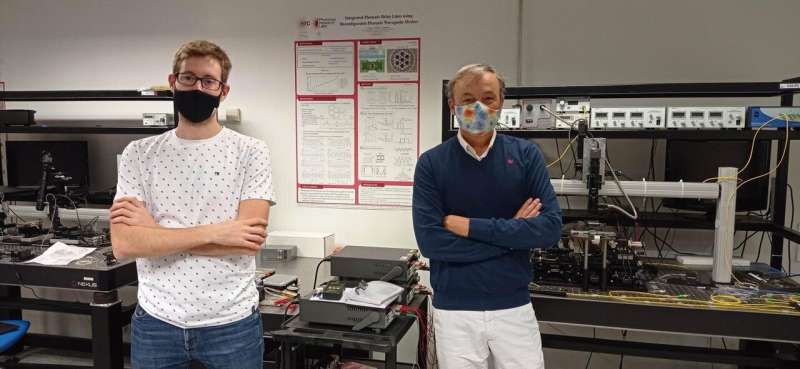Daniel Pérez and José Capmany Credit: UPV
The chips of the future will include photonics and electronics; they will have bandwidth, speed and processing and computing abilities that are currently unthinkable; they will make it possible to integrate many other components, and their capabilities will increase exponentially compared to electronic chips. In all, they will be essential in many fields; they will bring us a little closer, for example, to quantum computing or to the autonomous car.
The key resides in programmable photonics, a technology in which the Polytechnic University of Valencia (UPV), through the Photonics Research Labs of the iTEAM institute and its spin-off iPronics, programmable photonics SL, is today an international benchmark. This much is confirmed by Nature, which in its latest issue has published an article that analyzes the present and future of this discipline—programmable photonics—written, among others, by Photonics Research Labs researchers Daniel Pérez and José Capmany.
"Programmable photonics marks a before and an after in the field of telecommunications. It is a field with great potential and value, due to the complementarity it has with electronics. Our article includes all the progress that has been achieved heretofore around the world in this field, which is garnering increased levels of interest," highlights José Capmany.
Democratizing photonics
As part of this progress, special mention must go to the generic purpose programmable chips that the UPV research team is working on. These circuits are capable of providing numerous functionalities by using a single structure, in an analogous way to how microprocessors work in electronics. The article also includes the most recent landmarks in the development of chips for specific purposes—designed for a specific task—and mentions the research of European centers such as the University of Ghent and the Polytechnic University of Milan, or American centers such as the MIT, the University of Stanford and the University of Toronto.
"From a fundamental point of view, the article describes and presents the technology of integrated photonics and the different levels required—photonic hardware, control electronics and software—to make the most of the potential of this type of systems," adds Daniel Pérez.
For the UPV researchers, these technologies will make it possible to democratize photonics, which would entail a true revolution in the field of telecommunications.
"As well as for the autonomous car or quantic computing, integrated photonics will also help improve automated learning systems, 5G communications or the development of neuromorphic computing, with chips that will imitate the network of neurons of our brain and their connections. All these uses require great flexibility and the processing of large amounts of data at high speeds. And this is what programmable photonics offers, and it is what the article published in Nature addresses," highlights Daniel Pérez.
More information: Wim Bogaerts et al, Programmable photonic circuits, Nature (2020). DOI: 10.1038/s41586-020-2764-0
Journal information: Nature
Provided by Universitat Politècnica de València






















